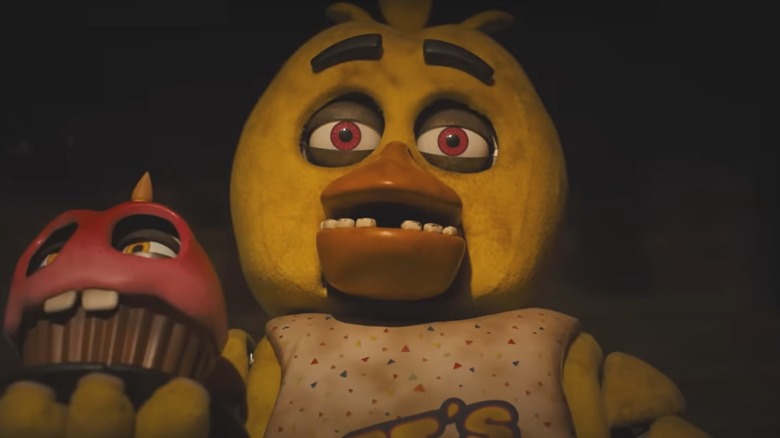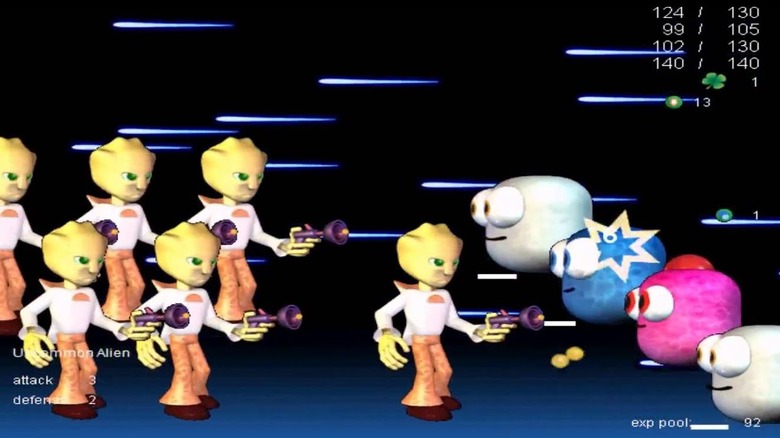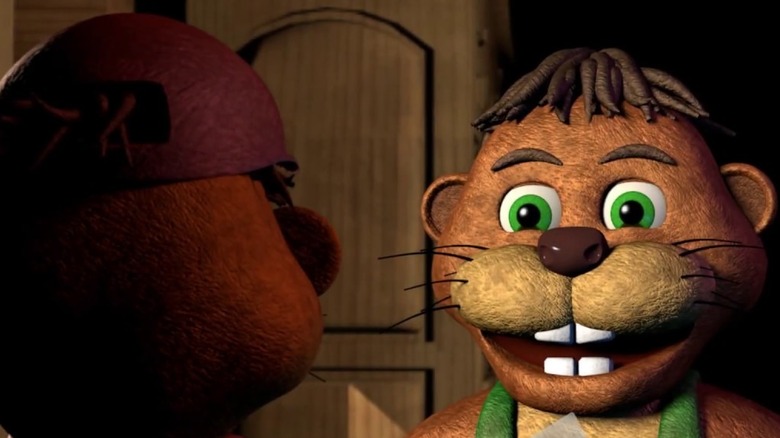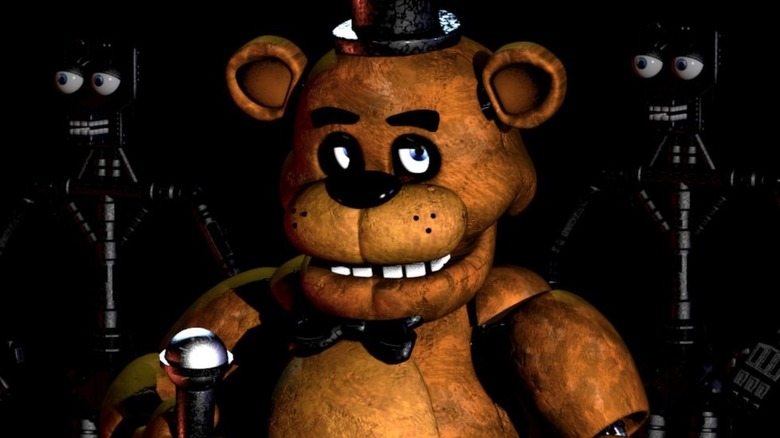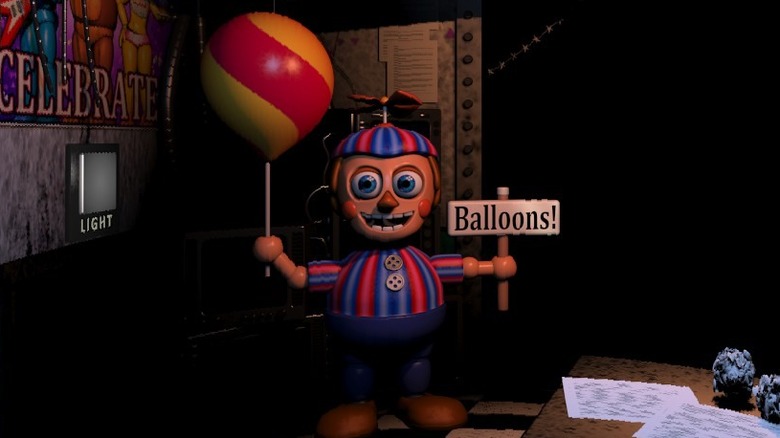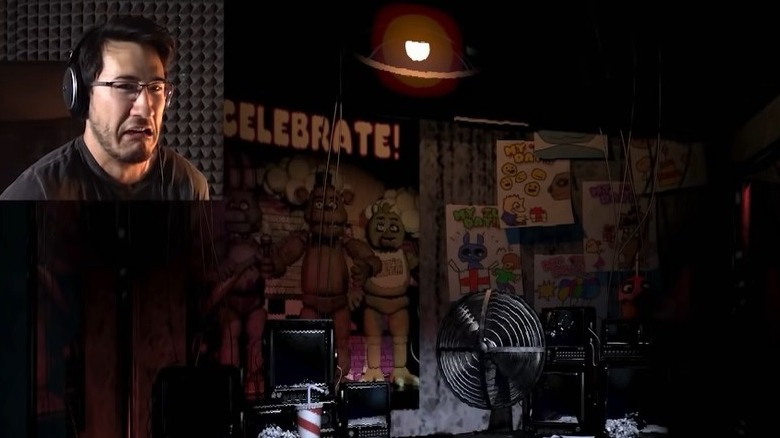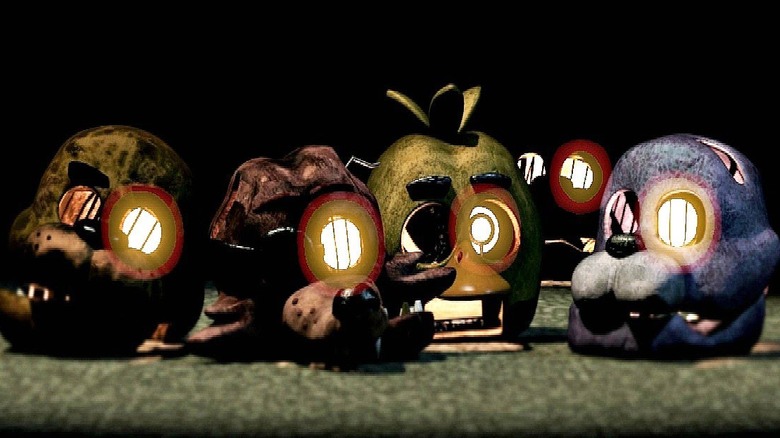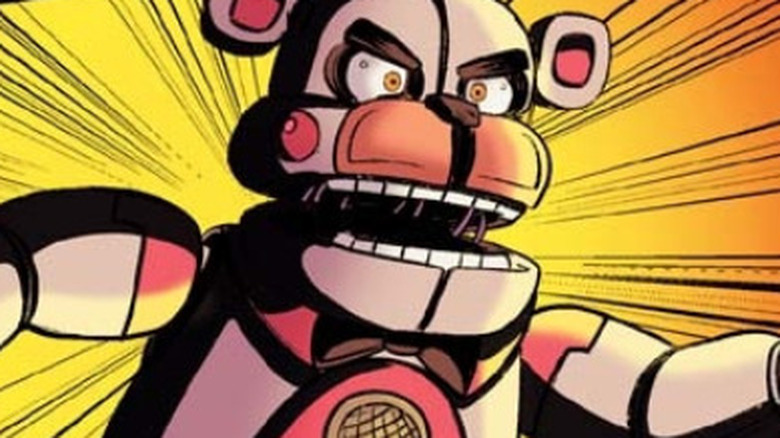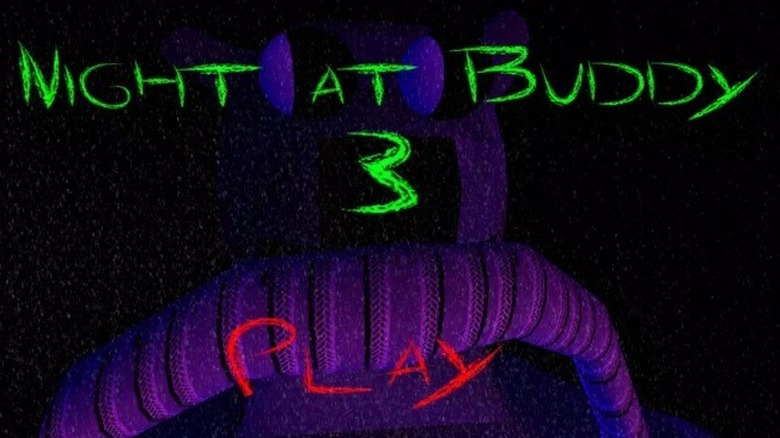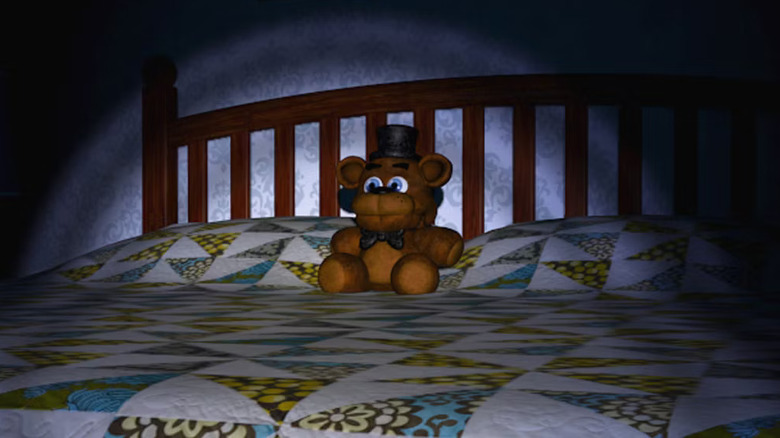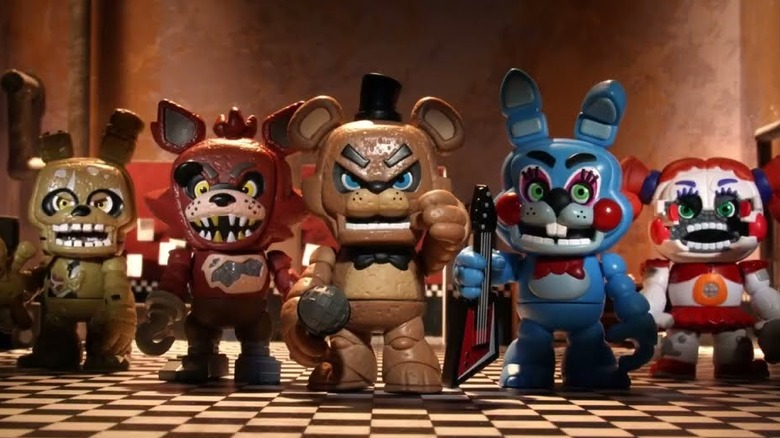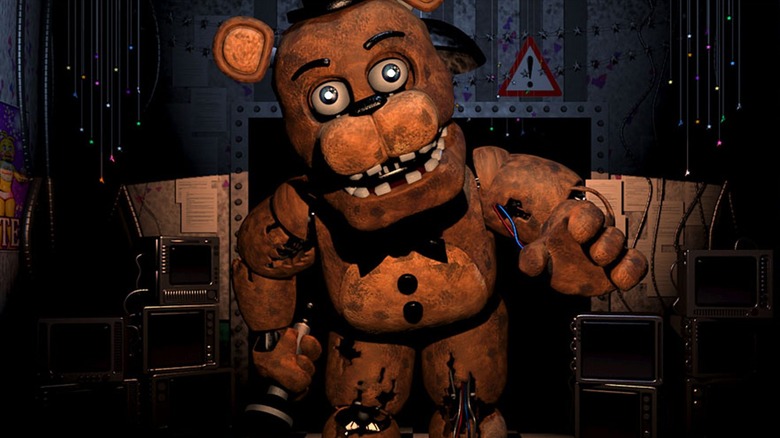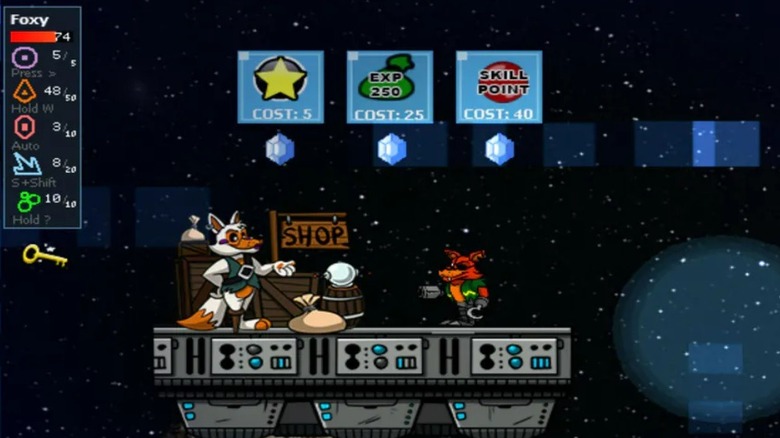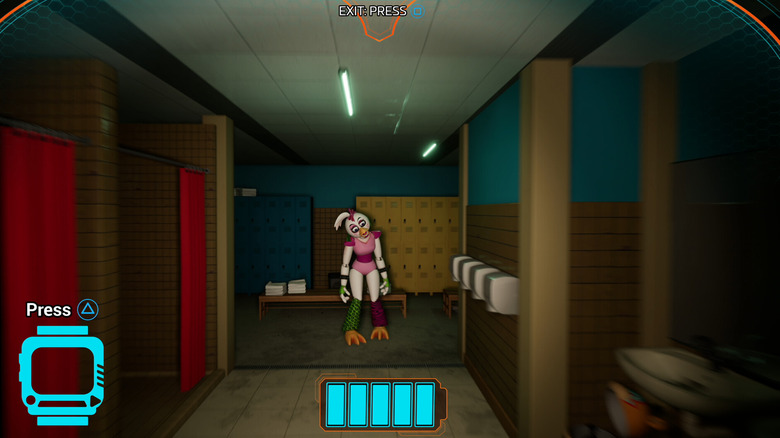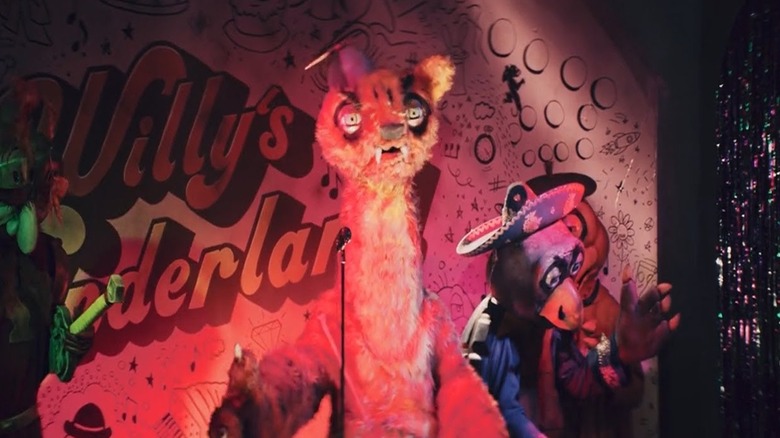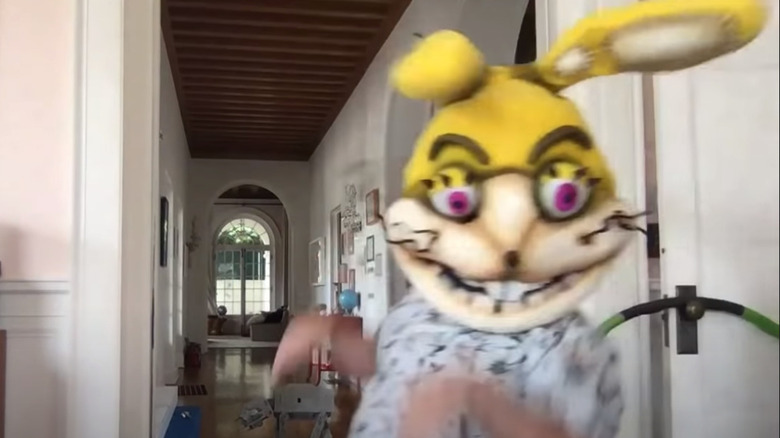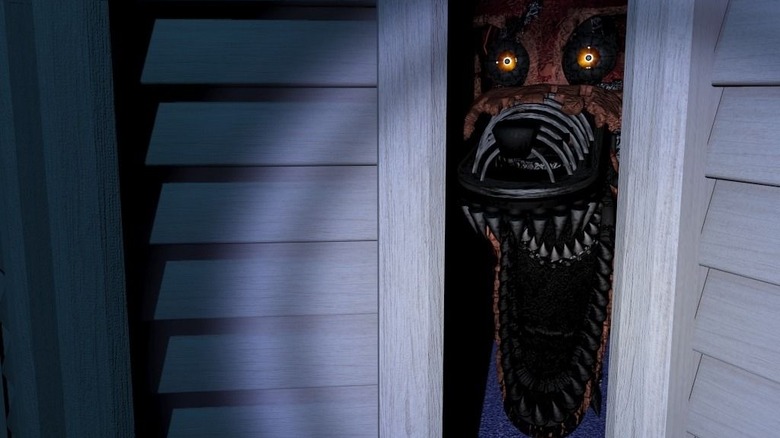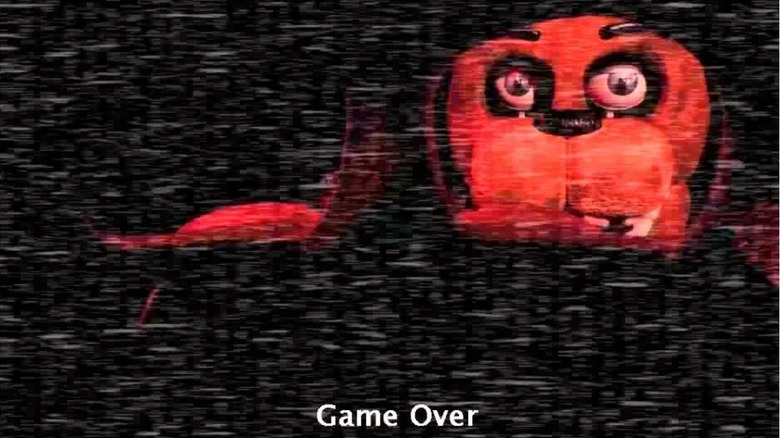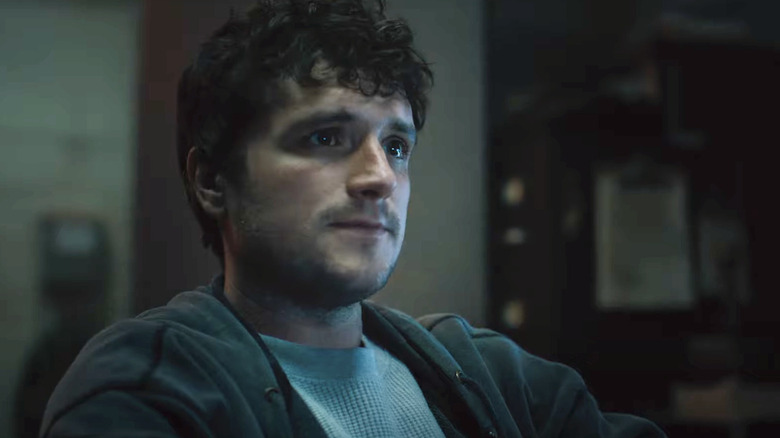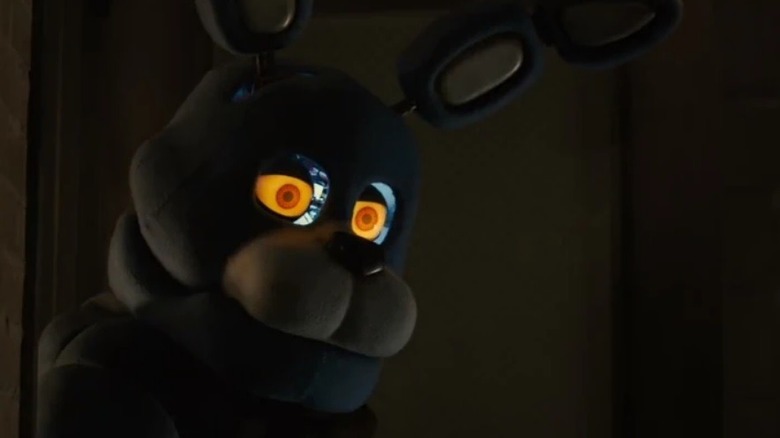Five Nights At Freddy's Rise From Indie Game To Full-Blown Movie Explained
Most of the time, it ends up being the huge video games, put out by major companies, that are chosen to be adapted into movies — "Super Mario Bros.," "Street Fighter," "Resident Evil," "Tomb Raider," and so on. So how did "Five Nights at Freddy's," a game that was created and distributed entirely by a single person, get to the point where it is getting a big-budget film distributed by Universal Pictures and Blumhouse Productions?
"Five Nights at Freddy's" — or "FNaF" for short — started out as a self-produced indie game that was built almost entirely around clicking between what were largely still images. To say that it captured lightning in a bottle would be an understatement, as it would take very little time for "FNaF" to grow into a multi-million-dollar brand that consisted not only of multiple video games but also books, toys, and more.
Here's the story of how a guy who had spent years as a struggling mobile game maker eventually became a co-writer on a major motion picture based on his creation — and whose estimated net worth is now $70 million.
Creator Scott Cawthon started out making family-friendly mobile games
Though most of the world hadn't heard of Scott Cawthon until "FNaF," that wasn't actually his first game. In fact, while details of his pre-"FNaF" career are somewhat scarce and much of it is difficult to fully confirm — owing in large part to Cawthon being a fairly private person and his website, ScottGames, now being nothing more than a black screen — information culled from various sources puts the number of games Cawthon had developed before "FNaF" at over 60.
Not all of those 60 games were fully-realized, commercially-released products. Many were just tech demos, fan games, and other such experiments created to help him hone his craft. The 2003 RPG "Legacy of Flan" is widely considered to be the first commercial game Cawthon ever released, with "Doofas the Dinosaur" — a simple game he made with a game creation program in the mid-'90s when he was just a teenager — being the earliest namable project of Cawthon's that anyone has been able to pinpoint.
Much of Cawthon's pre-breakthrough work consisted of family-friendly mobile games, some of which were Christian-focused and drew both praise and criticism for that fact. But what unites them all is that none sold well, and Cawthon still had a day job as a retail cashier until the "FNaF" money started rolling in.
FNaF was inspired by a bad review of one of Cawthon's games
Cawthon wasn't getting all that much attention for his work one way or another, positive or negative. But his 2013 game "Chipper and Sons Lumber Co." ended up on the radar of a few prominent game journalists — in particular Jim Sterling, known for his work with Destructoid and The Escapist. Sterling absolutely ripped "Chipper and Sons" apart, taking specific aim at the game's animal creatures and how unintentionally terrifying they looked. Cawthon also said that various people described the characters in the game as looking like creepy animatronic creatures comes to life.
"I was heartbroken and was ready to give up on game-making," Cawthon told Indie Game Magazine about the reaction to "Chipper and Sons." "Then one night something just snapped in me, and I thought to myself, I bet I can make something a lot scarier than that." And with that, Cawthon took the complaints about the characters in "Chipper and Sons" and turned them right back on his critics, making a game that specifically was about scary animatronics that come to life and try to kill people. "Five Nights at Freddy's" would be released the following year, and the rest is history.
FNaF represented a new approach to horror games
After years of big, bombastic, action-heavy horror games, the first few years of the 2010s saw a shift to games with little to no action component whatsoever, giving the player no direct recourse against a game's villain other than to run and/or hide from them. Even so, "FNaF" still managed to stand out for taking a particularly inventive approach to passive horror game experiences.
In the first "FNaF" game, the player is tasked with being the overnight guard at a restaurant with Chuck E. Cheese-esque animatronic mascots. While the restaurant is closed, the animatronics come to life and stalk the player with murderous intent. The player must switch between various security cameras in order to keep an eye on the animatronics, which only move when nobody is watching.
Though all of the images are static and contain no actual animation, looking at an image of all the animatronics together in one moment and then finding one missing when you return to that camera is unsettling. It creates plenty of tension without actually seeing them move, until they are right in your face just before they finish you off. The actual mechanics of the game are essentially built around resource management, as you only have a finite amount of power to use on each night, and every action — switching cameras, keeping the security doors closed, etc. — eats up a little of that limited energy.
The first two FNaF games were released in the same year
Considering how many games Cawthon managed to make before "FNaF," it's pretty obvious that he's able to work pretty quickly. And that speed also applied to the first "FNaF" game, which Cawthon developed in just six months in 2014 entirely on his own, except for the friends and family he enlisted to test it for bugs. Cawthon was already prone to making sequels to games he had affection for, whether they performed especially well or not, so it's possible he would have made "Five Nights at Freddy's 2" even without the positive buzz the first game was getting. Either way, he had a teaser for the sequel on his website only a month after the original game's release for PC, around the same time it began making its way to mobile devices.
"FNaF 2" would also see a quick turnaround, hitting PC, Android, and iOS in November 2014 — just three months after the original's PC release. The game, which ended up being a prequel to the original, had similar play mechanics with a few added twists. Most notably, various animatronic antagonists had specific criteria that needed to be filled in order to fend them off, including keeping a music box wound and needing to keep a flashlight trained on the hallways. There were also retro-style minigames that popped up whenever a player lost, which dug a little deeper into the characters and the lore.
It quickly became popular among gaming YouTubers
For gamers of a certain age, YouTube is the #1 source for which video games are new and hot. Especially if you're an indie developer or just have a game without a huge marketing push behind it, having YouTubers play and feature your game on their channels is the most effective way to get it in front of the eyes of potential players. "FNaF" also had the benefit of releasing at a time when horror games in particular were among the most popular genre of games for Let's Play videos, so it was all a perfect storm in giving Scott Cawthon his first viral hit.
Once "FNaF" started being not only featured but embraced by popular gaming YouTubers like PewDiePie, Jacksepticeye, and Markiplier, its popularity skyrocketed. In addition to just making entertaining videos of the hosts reacting hilariously to the famous "FNaF" game-ending jump scares, the clips were often titled to include massive praise of the game. In a video that would eventually have over 100 million views, Markiplier proclaimed "FNaF" "the scariest game in years" in the video's title, with a description that read, "'Five Nights at Freddy's' is incredibly unique and takes an approach to horror that I've never experienced before." The "FNaF" series secured its place among the all-time most Let's Play games within a year of its debut.
FNaF 3 was a divisive entry among fans
After the second "FNaF" game went the prequel route, "Five Nights at Freddy's 3" did a flash forward, taking place 30 years after the events of the first game. Cawthon had released the second game relatively early in the lifespan of "FNaF" hype, but by the time the third game hit in March 2015, things were already at a point where expectations were high and millions of people were waiting to play it. So it was on Cawthon to reinvent things a bit, especially after "FNaF 2" was mostly more of the same with just a few new wrinkles.
This time, the setting was a haunted house of sorts based on the restaurant chain from the original games, so horror was more baked into the premise than it had been before. All of the returning animatronics were now only ghosts who could mess with the player in various ways but not actually do physical harm. Instead, the gang of baddies from the previous games was instead replaced by newcomer Springtrap, the sole "living" animatronic and the only one who had the ability to kill the player. While everyone agreed that it was the most ambitious "FNaF" game yet from both a graphical and gameplay standpoint, some felt that the setting was lacking when compared to the originals, and that Springtrap wasn't a compelling enough villain to make up for the absence of an entire team of animatronics.
The franchise expanded into books and graphic novels
The original "Five Nights at Freddy's" was about little more than a security guard having to survive a workweek at the titular restaurant, whose mascot characters inexplicably come to life at night. Given the paper-thin plot of the original game, it would have been impossible to predict that one of the most popular aspects of the franchise among fans would be its complex and expansive lore. And while some of that was hinted at in the first couple of sequels, it wasn't until "FNaF" moved from the screen to the page that the overarching canon of its universe really began to unfold.
Cawthon co-wrote the first "FNaF" novel, "The Silver Eyes," in 2015, turning his creation from just a video game series into a true multimedia franchise by digging into the history of Freddy Fazbear's Pizza and its serial killer founder, William Atherton. Many hardcore "FNaF" fans were iffy on the book, due in part to the fact that it didn't seem to actually follow the continuity of the games, which Cawthon confirmed to be the case. Despite the backlash, "The Silver Eyes" became a New York Times best-seller which not only spawned multiple direct sequels but ended up launching a whole franchise of "FNaF" books, graphic novels, and more that have continued through 2023 — with more still on the way.
Fan games, mods, and straight-up clones flooded the market
Anything that reaches a certain level of popularity is bound to inspire imitators. The fact that "FNaF" is built on a relatively simple premise makes it especially prone to being ripped off, and it didn't take long before blatant clones of the series started to appear online and in app stores. Some at least attempted to pretend they weren't trying to copy "FNaF," or brought a different spin to the formula, while others — like the awkwardly-titled "Night at Buddy 3" — had far less shame.
It wasn't all just people trying to steal a piece of the financial windfall from a successful thing, though. "FNaF" also inspired mods in just about every game that allowed for them, from obvious ones like "Minecraft" and "Roblox," to more unusual examples, such as "Skyrim." And given Scott Cawthon's history with making fan games himself — he once made one based off the Nintendo franchise "Metroid" — he has been mostly supportive of "FNaF" fan games. He even launched the Fazbear Fanverse Initiative in 2020, wherein he helped to actually fund some of the more popular and ambitious "FNaF" fan games.
FNaF 4 shook up the setting and mechanics but failed to tie up loose ends
Making a fourth "FNaF" game that once again followed someone working the overnight shift at a place where animatronic mascots come to life at night would have really stretched the concept thin. So for the fourth installment, subtitled "The Final Chapter," Cawthon moved the action entirely away from a place of business and instead into a child's bedroom. This time, it was the child's stuffed animals of Freddy, Foxy, Bonnie, and Chica that became sentient and developed a thirst for blood when the sun went down.
The basic mechanics of "FNaF 4" were similar in that the player had to monitor the different places in the child's bedroom that a creature could emerge from, rather than the doors, windows, and vents of a security office. Taking place from the child's POV put the camera low the floor, and made the bedroom seem chillingly large to add to the tension. Critics and fans appreciated the change in setting and that the gameplay wasn't just more of the same, but the overwhelming vibe was that "FNaF 4" ultimately fell short.
Perhaps most damning was the fact that the game seemed to leave more questions than answers in terms of the franchise's lore, which frustrated fans who assumed that it being the "Final Chapter" meant that loose threads were going to be tied up and things were going to be fully explained.
FNAF toys and merch have been extremely popular
Where there's a hugely successful media brand, there inevitably comes merchandise. And "FNaF" is no different, with multiple Funko Pop! toys as well as plushies, action figures, playsets, and more. McFarlane Toys, which has made a name for itself as one of the premiere makers of toys for both kids and adult collectors alike over the past 30 years, quickly joined the fray with its own line of "FNaF" figures and sets beginning in 2016.
In addition to the expected figures based on the various animatronics, McFarlane Toys also has really cool construction playsets that can be rearranged and customized in various ways, with some having as many as 300 different pieces to work with. In a 2017 interview with Monkeys Fighting Robots, Todd McFarlane gushed about the success of the "FNaF" merch his company had been putting out, claiming that the construction playsets had done Lego numbers in terms of sales.
"[The FNaF toys are] selling like nothing I've ever done before," McFarlane said — and considering McFarlane Toys has worked with the likes of Disney and DC Comics, as well as taking on massive properties that include "Avatar," "Star Trek," "Stranger Things," "The Simpsons," and "The Walking Dead," that's really saying something.
Warner Bros. announced a FNaF movie in 2015
Plenty of video games have a film adaptation announced shortly after the game becomes popular, but the vast majority never see the light of day. The list of video game franchises that a filmmaker or movie studio had the rights to at one point, with things never moving beyond that initial announcement, is a long one, and includes "Call of Duty," "BioShock," "Metroid," "The Sims," "Half-Life," "Heavy Rain," "Crazy Taxi," "Asteroids," and many more. Some, like "The Last of Us," "Halo," and "Castlevania," at least eventually got television shows — but most aren't so lucky.
When Warner Bros. announced in 2015 that it was working on a "Five Nights at Freddy's" movie, it was impossible to know whether it would actually go anywhere or not. Fans were at least optimistic that Scott Cawthon was involved, with him telling The Hollywood Reporter, "The story really lends itself to being a movie, and it taps into a largely unexplored niche of horror that a lot of people will be able to relate to." Beyond that, all there was left to do was sit back and wait for updates — and to hope that there would actually be updates to share in the first place.
With the main series over, FNaF games continued via spin-offs
Even though "FNaF 4" purported to be the end of the main series, that didn't mean that there wouldn't be any more "FNaF" games at all. In fact, the very next year, in 2016, two spin-off games were released: role-playing game "FNaF World," and business management sim "Freddy Fazbear's Pizzeria Simulator." Also in 2016 was "Five Nights at Freddy's: Sister Location," which was more in line gameplay-wise with the original "FNaF" series. In fact, it's sometimes considered the fifth main game in the series as opposed to another spin-off — something seemingly confirmed by its later inclusion in the "Five Nights at Freddy's Core Collection" compilation.
The "FNaF" game franchise has barely slowed down since, adding the two-part "Help Wanted" side series, the augmented reality-based "Special Delivery," side-scrolling action game "Freddy in Space 2" (an expanded follow-up to a minigame from "FNaF World"), and more, including the franchise's first-ever free-roaming 3D game, "Security Breach," which we'll dig into more in a bit.
The movie switches to Blumhouse and director Chris Columbus
2017 brought good news and bad news in regard to the "FNaF" movie. First came the bad news, which was that Warner Bros. had given up the project and that all previous script work was being scrapped in favor of starting the writing process from scratch. Fortunately, it wouldn't be the only update fans got about a "FNaF" movie that year — and the next one was much more positive.
Blumhouse, the production company known for hit horror movies like "Paranormal Activity," "The Purge," and the most recent "Halloween" trilogy, was now shepherding the "FNaF" movie. Moreover, a new director was attached — Chris Columbus, who many immediately associate with light family fare like "Home Alone" and "Mrs. Doubtfire," but forget that he was also the writer of "Gremlins" and directed the first two "Harry Potter" films. Plus, having someone with his level of clout could only mean good things for the "FNaF" movie finally getting rolling. At least, that was the hope.
The FNaF games break out of their indie confines with Security Breach
What had united all of the "FNaF" games up to this point was that they all very much felt like the work of one person, created over a fairly short period of time. That isn't a knock on the series or on Scott Cawthon's talent — that scrappy approach was a big part of the series' charm — but it doesn't make it any less of a fact that the games all had that low-budget, indie feel. Well, that all changed with the announcement of "Security Breach," the first "FNaF" game to actually look, sound, feel, and play like a modern, big-budget AAA video game.
Released in 2021, "Security Breach" definitely allowed fans to explore the world of "FNaF" in a way they never had before, featuring fully 3D environments that players could freely walk around in. Other changes included the setting being a shopping mall, the game taking place entirely within a single night rather than five, the ability to actually directly attack enemies, and a new version of Freddy — Glamrock Freddy — that served as the player's ally rather than enemy.
Though critical response was tepid beyond praise for the production values, fans seemed to be a bit more positive, with the PlayStation version winning a Player's Choice Award via the PlayStation Blog. An expansion called "Ruin" was added to the game in July 2023 and was also well-received by fans.
With the FNaF film stalled, similar movies filled the void
With mostly radio silence surrounding the second iteration of the "FNaF" movie in the two years since the last update, 2019 saw the announcement of "Willy's Wonderland." The film starred Nicolas Cage as the janitor of an abandoned family restaurant whose animatronic mascot characters come to life at night with a lust for blood. Sound familiar? Many drew parallels between "Willy's Wonderland" and "FNaF" when the former was finally released in 2021, with some outlets — including the one you are currently reading — referring to it as a clone.
Screenwriter G.O. Parsons claimed that he first wrote the script for "Willy's Wonderland" in 2011, which would pre-date the first "FNaF" game. In his defense, it's not as though nobody else had ever noted the creepiness of animatronic humanoid animals or implied that they might be evil before Scott Cawthon did. But would "Willy's Wonderland" have been greenlit and released had it not been for the popularity of "FNaF"? It's impossible to say for sure. Just like it's impossible to say whether "The Banana Splits Movie," released in 2019 and also about animatronic animals that decide to start murdering people, was likewise trying to capitalize on the unsatisfied hunger for a "FNaF" film and wouldn't have existed otherwise.
Jack Black raised FNaF's profile even further
While hardcore "FNaF" fans' love for the game hasn't wavered much over the years, the franchise has definitely ebbed and flowed a bit within the mainstream public's consciousness. And for a major studio motion picture to be a hit, you need more than just the hardcore fans to show up for it. So in an era of somewhat niche game spin-offs, graphic novels, and other things that a casual or non-"FNaF" fan wouldn't care about, what can be done to keep the brand's name on people's minds?
Enter Jack Black — actor, musician, and most importantly, loud and proud gamer. Black has always been a champion for the games he enjoys, not only on his YouTube channel, Jablinski Games, but even in talk show appearances. For instance, in a 2020 video interview from his home with Jimmy Kimmel, there's a moment where Black disappears from the frame and when he emerges, he's wearing a Glitchtrap mask. Also that year, Black posted a brief video on TikTok decked out in Freddy Fazbear's Pizza pants and singing a bit of the Living Tombstones' "FNaF" song, eventually amassing nearly four million views. Not only did these viral clips delight "FNaF" fans, but they served to remind the rest of the world about the franchise and keep it in the pop culture discourse.
The Blumhouse movie had script problems and lost Chris Columbus
Despite Jack Black helping to spread the word about "FNaF" in 2020 and increasing its pop culture cache, 2021 saw the "FNaF" movie get yet another disappointing update. Blumhouse's Jason Blum revealed that Chris Columbus had left the project, but didn't elaborate as to why or if another director was lined up. He further explained that nailing down a final script continued to prove difficult, especially in terms of coming up with something that Scott Cawthon approved of, while reaffirming that the "FNaF" movie wasn't going to happen until Cawthon was satisfied with the script.
This left fans more than a little confused, as the Blumhouse Twitter account had stated the previous November that shooting on the movie was set to begin in the spring. How does a movie go from being ready to shoot, to not having a director or even a finished script? It was definitely reassuring that updates continued to come — which is more than can be said for most video game movies that we hear virtually nothing about after the initial announcement — but those updates typically ended up being bad news more often than good. So the wait for the "FNaF" movie resumed, a wait that had now entered its sixth year.
Scott Cawthon retired from game development
Another potential blow to the future of not only the "FNaF" movie, but the franchise in general, came in June 2021 when Scott Cawthon announced he was retiring from making commercial video games. Cawthon had been embroiled in a backlash over his alleged political views, stemming from the discovery that he had made large donations to various Republican politicians' campaigns, including that of Donald Trump.
Cawthon released a statement in which he claimed that he had also made donations to Democrats, and also responded to criticisms that the politicians he made donations to were anti-LGBTQ by insisting that he supported and appreciated the LGBTQ community — in particular, those that were part of his fan base. But it all got to be too much for Cawthon and he decided to shift toward a more private life. He stated that he'd only make video games as a hobby going forward, and that he would eventually cede control over the "FNaF" franchise to someone else. This begged the question of whether he was going to bail on his involvement in the "FNaF" movie, especially at a time when the project remained in limbo anyway, but those fears were eventually put to rest.
The FNaF movie finally gets a cast, trailer, and release date
Halfway through 2022, the updates on the "FNaF" movie resumed — and they seemed to point to a project that was finally, officially underway. In August, it was confirmed that Jim Henson's Creature Shop was making the animatronics for the film, with Jason Blum even sharing an image on Twitter of someone who was clearly working on a Freddy model. Three months later, Emma Tammi was announced as the new director, and was working on the script with Cawthon and Seth Cuddleback. Finally, December brought news of Josh Hutcherson, Matthew Lillard, and Mary Stuart Masterson joining the cast.
It seemed like the "FNaF" movie was not only finally being made, but wasn't too far off from actually coming out. The final pieces to the puzzle came in May 2023, when the first teaser trailer was released alongside the reveal of the movie's October 27, 2023 release date. Eight years after the first announcement and many disappointing updates that made it seem like it would suffer the same fate as so many other video game movies, "Five Nights at Freddy's" was finally coming to both the big screen and Peacock.
There are plans for an entire FNaF film trilogy
Of course, the "FNaF" movie isn't out yet, so we don't know how good it is or if it'll be successful. The fact that Blumhouse has been willing to wait until Scott Cawthon was happy before filming could even officially start seems to point toward it being at least faithful to the spirit of the source material, but that doesn't necessarily mean it'll connect with a big enough audience to be deemed a hit. Still, that hasn't stopped Cawthon from envisioning what a second and third "FNaF" movie might look like.
Way back in 2018, Cawthon said that he already had an outline for an entire "FNaF" movie trilogy, adding that the second movie would follow the second game and the third would follow the third game. That's far from confirmation of anything, and it all depends on the first "FNaF" movie doing well enough to even have sequels at all, but it's still interesting to note that it's been on his mind. However, Matthew Lillard revealed on an episode of the podcast "WeeklyMTG" that his deal with Blumhouse was for three movies — and that immediately led to speculation that Blumhouse was also already getting its ducks in a row for a "FNaF" film trilogy. Time will tell, but it seems like a safe bet to prepare for more "FNaF" on the big screen in the future.
